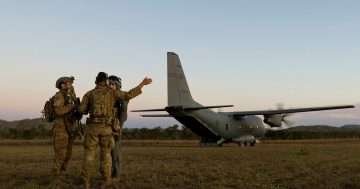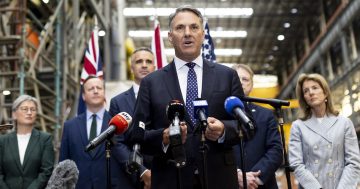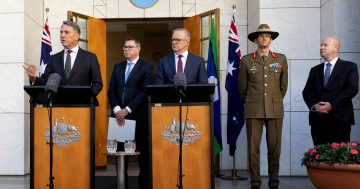
The first financial allocations for the two pillars of the AUKUS agreement have been made in the 2023-24 budget. Photo: ADF.
The 2023-24 Federal Budget has provided few surprises for the Defence portfolio, with most of the priorities having already been identified in last month’s Defence Strategic Review (DSR) and a number of announcements made since.
The government says it is building on its commitment to implement the recommendations of the DSR by accelerating and growing some projects while scaling back others. As a percentage of GDP, Defence is expected to stay at or near the forecast 2 per cent, with a modest increase to 2.2 per cent by 2032-33.
“The Albanese Government has made no secret that we are willing to make the hard decisions in order to get the best outcome for our ADF,” Defence Minister Richard Marles said in a budget release.
“Ultimately, Defence spending will grow over the medium term, which is in line with the strategic circumstances.”
The recommendations from the DSR will account for $19 billion over the four-year forward estimates period, including the first funding commitment for the two pillars of the AUKUS construct. Some of these key outlays include:
- $9 billion for the AUKUS nuclear-powered submarine (SSN) program
- $4.1 billion for land, air, and ship-launched long-range strike capabilities
- $3.8 billion for northern base infrastructure improvements and resilience
- $400 million to support ADF personnel through a new retention bonus scheme
- $900 million to establish the Advanced Strategic Capabilities Accelerator (ASCA) and fund the first elements of Pillar 2 of AUKUS.
“We need the right capabilities for our strategic circumstances. That’s why the Albanese Government is investing $4.1 billion over four years on long-range strike and establishing an Australian missiles and munitions industry,” Minister for Defence Industry Pat Conroy said.
Assistant Minister for Defence Matt Thistlethwaite added, “Hardening the ADF’s northern base infrastructure and making Defence’s information networks more resilient are essential to strengthen our posture and accelerate preparedness.
The government says these and other budget elements are central to Australia’s security and the collective security of the wider region. To this end, it includes additional funding for defence partnerships in the Indo-Pacific, which is in line with the DSR’s ‘whole-of-government’ approach to regional security.
Part of this funding will come from a $7.8 billion “reprioritisation” of the Defence Integrated Investment Plan (DIIP). In other words, this money will come from the reduction or delay of some projects, such as Army’s LAND 400 Phase 3 Infantry Fighting Vehicle requirement, and the cancellation of others. This funding will be rolled into the government’s first National Defence Strategy, projected to be delivered in 2024.
To deliver this whole-of-government approach, the budget calls on state and territory governments, communities and industry to do their part to not only defend the nation but Australia’s regional interests. To this end, additional funding will be committed to developing skills and the workforce required to deliver sovereign capabilities through a more diverse defence industry.
In addition to the funding that will be committed to the nuclear-powered submarine program, $11.4 million has been committed over three years to develop and extend the Defence Industry Pathways Program in Western Australia’s shipbuilding sector.
And apart from the $400 million retention bonus scheme and the promised study into ways to improve defence housing, an additional $328.1 million has been allocated in 2023-24 to support the ADF’s 340,000 veterans and dependants through the Department of Veterans’ Affairs (DVA).
The government says this amount is in addition to the $537.5 million announced in the October 2022 Budget. It is part of its commitment to make significant investments that will reduce the veteran compensation claims backlog.
Of this, $64.1 million will be spent on training 480 DVA staff and $254.1 million to upgrade and sustain ageing IT systems.
About the retention bonus, former ADF special operations officer and co-founder and CEO of defence services and technology company UBH Group Jeff Batten told Region, “We welcome any incentive to address the recruitment and retention problems the ADF is seeing, but I think the issue would be enhanced by a broader non-monetary suite of initiatives around the value of service and the opportunities the ADF presents.
“What we really need is the Defence workforce model to mirror more closely contemporary common practice across other sectors. And, apart from high readiness forces, this really should be able to happen.”
On the wider Defence budget, Mr Batten said, “Increased Defence spending (even if it is a reinvestment process from other areas) needs to come with clear communication to the wider Defence industry on what is expected of them to help deliver these capabilities.
“What industry does best is deep technological expertise and support, but that still takes time to develop and scale. For example, missiles don’t just require a manufacturing and maintenance capability, there’s also a communications network to support their coordination that needs to be built and secured against cyberattacks.
“The increasing complexity of our Defence strategy requires greater collaboration, not just with the Prime (contractors), but with smaller sovereign technology providers too so they can plan investment accordingly to meet the needs of Defence. By getting this right, Australian sovereign technology will play a meaningful role in our defence in the years to come.”





















